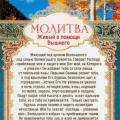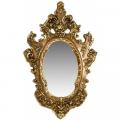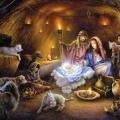The first ever meeting of the Pope and the Patriarch of Moscow took place only in February 2016 on neutral Cuban territory. The phenomenal event was preceded by setbacks, mutual suspicion, centuries of enmity and attempts to reduce everything to peace. The division of the Christian Church into Catholic and Orthodox branches occurred due to disagreements in the interpretation of the "Symbol of Faith". So because of the only word according to which the Son of God became another source of the Holy Spirit, the church was divided into two parts. Less preceded by the Great Schism, which eventually led to the modern state of affairs.
The split of the church in 1054: reasons for the division of Christians
Ritual traditions and views on dogmatic principles in Rome and Constantinople began to gradually differ long before the final separation. In the past, communication between states was not so active, and each church developed in its own direction.
- The first preconditions for a split began in 863. For several years, Orthodox and Catholics have been in opposition. The events went down in history as Fotieva Schism. The two ruling church leaders wanted to divide the land, but did not agree. The official reason was doubts about the legality of the election of Patriarch Photius.
- Ultimately, both religious leaders anathematized each other. Communication between the heads of Catholics and Orthodox was resumed only in 879 at the Fourth Council of Constantinople, which is now not recognized by the Vatican.
- In 1053, another formal reason for the future Great Schism stood out clearly - the dispute over unleavened bread. The Orthodox used leavened bread for the sacrament of the Eucharist, while the Catholics used unleavened bread.
- In 1054, Pope Leo XI sent Cardinal Humbert to Constantinople. The reason was the closure of Latin churches in the capital of Orthodoxy that happened a year earlier. The Holy Gifts were thrown away and trampled underfoot because of the unleavened method of making bread.
- The papal claims to land were based on a forged document. The Vatican was interested in obtaining military support from Constantinople, and this was the main reason for the pressure exerted on the Patriarch.
- After the death of Pope Leo XI, his legates nevertheless decided to excommunicate and depose the leader of the Orthodox. The retaliatory measures were not long in coming: four days later, they themselves were anathematized by the Patriarch of Constantinople.
The split of Christianity into Orthodoxy and Catholicism: results
It seemed that half of the Christians could not be anathematized, but the then religious leaders saw this as acceptable. Only in 1965 did Pope Paul VI and Ecumenical Patriarch Athenagoras abolish the mutual excommunication of churches.
After another 51 years, the leaders of the divided churches met for the first time in person. The deep-seated divisions were not so strong that religious leaders could not be under the same roof.
- The millennia of existence without reference to the Vatican has strengthened the separation of the two approaches to Christian history and the worship of God.
- The Orthodox Church never became united: there are many organizations in different countries, headed by their Patriarchs.
- The Catholic leaders realized that neither subjugating nor destroying the offshoot would work. They recognized the vastness of a new religion equal to their own.
The split of Christianity into Orthodoxy and Catholicism did not prevent believers from praising the Creator. Let representatives of one confession perfectly pronounce and recognize dogmas that are unacceptable to another. Sincere love for God has no religious boundaries. Let Catholics dip babies at baptism once, and Orthodox Christians three times. Little things of this kind matter only in mortal life. Appearing before the Lord, everyone will be responsible for their actions, and not for the decoration of the temple they have visited earlier. There are many things that unite Catholics and Orthodox Christians. First of all, it is the Word of Christ, followed with humility in the soul. It is easy to find heresy, it is more difficult to understand and forgive, to see in everyone - the creation of God and his neighbor. The main purpose of the Church is to be a shepherd for the people and a shelter for the disadvantaged.
The division of the Ecumenical Church into Eastern and Western took place under the influence of many very different reasons, which for centuries, superimposed on each other, undermined the unity of the Church, until the last connecting thread was finally broken. Despite all the variety of these reasons, we can conditionally distinguish two main groups among them: religious and ethno-cultural.
There are two religious reasons for the split: the desire of the Roman high priests for absolute power over the Church and dogmatic deviations from the purity of the catholic doctrine, among which the most important is the change in the Niceo-Constantinople Creed by inserting a filioque. It directly violates the 7th rule of the III Ecumenical Council, which determines: "May no one be allowed to pronounce ... or to lay down a different faith, except for those who were determined from the saints in the city of Nicaea with the Holy Spirit gathered."
The next group of phenomena that decisively contributed to the weakening of church unity even at a time when it was still preserved belongs to the area of national and cultural conditions for the development of Christianity in the West and in the East.
In church history, there is a point of view according to which Rome deliberately exacerbated relations with the East before the Great Schism, seeking to break them. There were reasons for such a desire, for the disobedience of the East clearly constrained Rome, undermined its monopoly, therefore, as he writes: “The East refuses to obey and there is no way to force it to obey; it remains to declare that obedient churches are all true. "
The reason for the final rupture in July 1054 was another conflict over the ecclesiastical possessions of Pope Leo IX and Patriarch Michael Kerullarius. Rome for the last time tried to achieve unconditional obedience to the East, and when it became clear that this was impossible, the papal legates, “missing, in their own words, the resistance of Michael,” appeared in the temple of Hagia Sophia and solemnly placed the bull of excommunication on the throne. which read "By the authority of the Holy and indivisible Trinity, the Apostolic See, of which we are ambassadors, all the holy Orthodox Fathers of the Seven Councils and the Catholic Church, we sign against Michael and his adherents - an anathema that our Reverend Pope pronounced against them if they do not come to their senses." The absurdity of what happened was complemented by the fact that the pope, on whose behalf they pronounced the anathema, was already dead, he died in April of this year.
After the legates had departed, Patriarch Michael Kerullarius convened a Council, at which the legates and their "unholy scriptures", after consideration, were anathematized. It should be noted that not all of the Western was anathematized, just as Cardinal Humbert did in relation to the Eastern, but only the legates themselves. At the same time, of course, the condemnation of the Councils of 867 and 879 remains in force. concerning Latin innovations, filioque and papal claims to primacy.
All Eastern patriarchs were notified of the decisions made by the district epistle and expressed support for them, after which church communication with Rome ceased throughout the East. No one denied the honorary primacy of the pope, established by the fathers, but no one agreed with his sovereignty. The agreement of all Eastern primates in relation to Rome is confirmed by the example of Peter III, the patriarch of Antioch, where the name of the pope was deleted from the diptychs long before the Great Schism. His correspondence with the Roman See on the possibility of restoring unity is known, during which he received a letter from Rome outlining the papal point of view. It amazed him so much that Peter III immediately sent it off to Patriarch Michael, accompanied by very expressive words: “These Latins, after all, are our brothers, despite all their rudeness, ignorance and addiction to their own opinion, which sometimes drives them away from direct roads ".
The Holy Synod of the Church of Constantinople canceled the decree of 1686 on the transfer of the Kiev Metropolis to the Moscow Patriarchate. The granting of autocephaly to the Ukrainian Orthodox Church is not far off.
There have been many schisms in the history of Christianity. It all began not even with the Great Schism of 1054, when the Christian Church was divided into Orthodox and Catholic, but much earlier.
All images in publication: wikipedia.org
The papal schism in history is also called the Great Western. It happened due to the fact that at almost the same time, two people were declared pope at once. One is in Rome, the other is in Avignon, the site of the seventy-year captivity of the popes. Actually, the end of the Avignon captivity and led to disagreements.
In 1378, two popes were elected at once
In 1378, Pope Gregory XI died, interrupting the captivity, and after his death, the supporters of the return elected the pope in Rome - Urban VI. The French cardinals, who opposed the departure from Avignon, made Clement VII pope. The whole of Europe was also divided. Some countries supported Rome, some - Avignon. This period lasted until 1417. The popes who ruled at this time in Avignon are now classified as antipopes by the Catholic Church.

The first schism in Christianity is considered to be the Akakian schism. The split began in 484 and lasted 35 years. Controversy flared up around the "Enotikon" - the religious message of the Byzantine emperor Zeno. It was not so much the emperor himself who worked on this letter, but the Patriarch of Constantinople Akaki.
Akakian Schism - the first schism in Christianity
On dogmatic issues, Akaky did not agree with Pope Felix III. Felix deposed Akaki, while Akaki ordered to delete the name of Felix from the memorial diptychs.
The tension between Constantinople and Rome grew and grew. Mutual discontent resulted in the Great Schism of 1054. The Christian Church was then finally divided into Orthodox and Catholic. It happened under the Patriarch of Constantinople Michael I Kerularia and Pope Leo IX. It got to the point that in Constantinople they threw away and trampled the prosphora prepared in the Western manner - without leaven.
1054th - the year of the Great Schism
For many centuries, the Catholic and Orthodox Churches have remained formally irreconcilable enemies. Only in 1965 the mutual anathemas were lifted, but contradictions and discrepancies remain to this day.

The disintegration of the Christian Church into a Catholic Church with a center in Rome and an Orthodox Church with a center in Constantinople was brewing long before the final division in 1054. The forerunner of the events of the 11th century was the so-called Fotie's schism. This schism, dating from 863 - 867, was named after Photius I, the then Patriarch of Constantinople.
Photius and Nicholas excommunicated each other
Photius's relationship with Pope Nicholas I was, to put it mildly, strained. The Pope intended to strengthen the influence of Rome on the Balkan Peninsula, but this provoked resistance from the Patriarch of Constantinople. Nicholas also appealed to the fact that Photius became the patriarch illegally. It all ended with the church leaders anathematizing each other.
Church schism 1054 years are often called the Great Schism. The participants in those events themselves did not realize how great the consequences would be for Europe and the world. Europe was divided into Catholics and Orthodox Christians, this entailed some cultural, value, and later political differences. The article describes the course of the church schism 1054 years, and also analyzes the causes and consequences of these events.
Events before the split
The origins of the conflict are to be found in 395 year, when the Roman Empire, which had become a Christian country by that time, fell into two parts: Western Roman Empire and Byzantium... And although Rome was noticeably weaker than Constantinople in political terms, the Pope remained the head of the church. This means that Rome was a religious center. In the 9th century, the Fotiev schism took place: Photius was elected Patriarch of Constantinople, but at the same time the Pope did not recognize him, since he believed that the appointment of the patriarch did not go according to the rules. The real reason lies in the Pope's desire to extend his influence to the Balkans, since if Phocius was not recognized, he could easily establish his bishops there. In this conflict, the Byzantine emperor supported Phocius, which intensified the dispute and made it also political.
Reasons and reasons for the split
During the 9th-10th centuries, there were frequent disputes regarding certain rituals and religious subtleties. This is what gave rise to a conflict and, as a consequence, a split.
The main reasons for the split
- The status of the Holy Spirit. In Rome, it was believed that the Holy Spirit proceeds from the Father and the Son, and in Constantinople - only from the Father.
- Purgatory. The supporters of the Patriarch of Constantinople did not recognize the existence of the concept of "purgatory" at all. Either hell or heaven, there is no intermediate place.
In addition, there was still a lot of controversy regarding how to receive communion (for example, what kind of bread), what clothes should be for priests, etc. But the main reasons for the split were not at all in dogmas, the dispute was caused by the political situation.
The main reasons for the split
- Dispute between the Patriarch of Constantinople and the Pope regarding the primacy in the church world.
- The reluctance of the emperor of Byzantium to obey the Pope.
- The desire of both religious centers to extend their influence to the peoples who have not yet adopted Christianity. As a consequence, the conflict was also related to land and money.
Split course
V 1053 year in Constantinople, all the churches subject to Rome were closed. The reason - they held services according to the wrong rituals. Pope Leo IX sent his ambassadors to the capital of Byzantium to resolve the conflict. As a result, a message was sent to the Pope justifying the closure of churches and a categorical refusal to open them. The Pope's ambassadors were soon excommunicated. A year later, in 1054 year in Constantinople, the ambassadors of the Pope arrived, entered the Hagia Sophia and laid the letter, which was excommunicated from the church of the patriarch. The patriarch's supporters were called "schismatics", that is, those who split the church. They called themselves "Catholics", that is, supporters of the "universal church".
Further differences between Catholicism and Orthodoxy
- Center status. Catholics have only one head of the church (the Pope). The Orthodox have several patriarchs. In addition, over time, local Orthodox churches arose: Russian, Georgian, Ukrainian.The limits of papal authority are defined by the Dictatus Pape, a document consisting of 27 paragraphs stored in the register of letters to Gregory VI I († 1085). At the time of the split, in addition to the Roman and Constantinople Patriarchates, there were also Jerusalem, Antioch and Alexandria. Moreover, each of them was completely independent. This dogma refuted all the teachings of the Apostles, who advocated the equality of church communities, Rome could only be "the first among equals." But he wanted to become the only installer of the horses and a judge in all church patriarchates. The dispute about the primacy of the Patriarchate of Constantinople was not raised at that time, so there was no controversy on this issue. Constantinople opposed the usurpation of power by Rome.
- The role of the church in political affairs. Throughout the Middle Ages, there was a conflict between kings and popes over the right of supremacy in the Western world. In Orthodox countries, however, everything was monotonous: the monarch was considered higher than the patriarch.A painful attitude towards the power of Rome manifested itself in his disputes with kings and emperors. In Constantinople, such attempts to seize power by the patriarch were suppressed at an early stage. Nikon is a striking example in Russian history. In the absence of the tsar, he issued decrees and endorsed the decisions of the boyars. In principle, he fulfilled completely the royal duties. The patriarch had the power to judge church affairs. It was in fear of such a dual power that Peter established the Synod and abolished the Patriarchate.
- The calendar. After being adopted in 16 century of the new Gregorian calendar, all Catholic countries switched to a new chronology. The Orthodox Church uses the Julian calendar to this day.Exists 5 Orthodox churches that live according to the Julian calendar, the rest live according to the New Julian calendar, which until 2800 will coincide with the Gregorian one. Therefore, it is difficult here to make a distinction between Orthodoxy and Catholicism.
- Parishioners' rules... During services in Orthodox churches, parishioners must defend Mass, while Catholics are allowed to sit on benches.There are benches in Orthodox churches too. And there is an expression, it is better to think about God while sitting than standing about your feet.
- The sacraments of the church. The Orthodox is in front of the priest during confession. Catholics, however, are located behind a screen, so the priest does not see who exactly came to him.The main difference is that in Orthodoxy, confession goes before Christ and in the prayer of absolution, which the priest reads, it is said about it. In Catholicism, the release of sins is carried out by a priest, which is also indicated by the words of his prayer.For your information: Baptism in Orthodoxy goes on with the words: the servant of God is baptized in the name of ..., and in Catholicism I baptize the servant of God ... does not part. In Catholicism: the spouses themselves are the performers of the sacrament. If we take the sacrament itself, then there are differences from the anophora (part of the Eucharistic canon) to the sacrament itself. In Orthodoxy, everyone partakes of the blood and body of Christ; in Catholicism, only priests receive communion under two forms, parishioners only of the blood of Christ. Children up to 12- Those years are not allowed to commune for safety reasons (their actions can lead to the falling of the blood of Christ on the earth). The sacrament of chrismation in Orthodoxy is carried out immediately after baptism (if this did not happen for one reason or another, that is, the expression: to baptize, that is, to carry out chrismation, which is an independent sacrament). In Catholicism, this is called confirmation and is carried out only after 12- years old. Unction: in Orthodoxy, this is an ordinary sacrament, which is carried out by fasting for many days, in Catholicism only with the threat of death. (but this can be attributed more to the ritual distinction).
- Influence on the language. For the Pope, the use of Latin by Catholic countries was obligatory, but the Patriarch of Constantinople allowed the use of his letter.Both Constantinople and Rome considered it possible to write Holy Scripture in three languages: Hebrew, Greek and Latin. This tradition was violated in Rome, when Cyril and Methodius were allowed to translate the scriptures into the Slavic language. For a long time in Rome, ministry in local languages was not welcomed (the primary reason was the fear of distortion during translation), Only after 1970-
In the same year, parishes of Roman Catholics were given the right to carry out services in their own language. So here, too, one can speak only of tradition, and even then in the past tense.
The main differences still lie in the spiritual sphere, the filioque is one of the obstacles, but for 1000 years, new dogmas appeared that contradict both Scripture and Tradition.
After the split, the difference between some of the peoples of Europe increased. A striking example is the Slavic peoples: those who came under the rule of Rome took Latin and the Latin alphabet as a basis. Many Orthodox countries began to develop their writing based on the Cyrillic alphabet.
In a global sense, due to the split of the Roman Empire and the subsequent emergence of Byzantium and the early medieval societies of Western Europe, which were politically and culturally far apart from each other.
Many times more people lived in the east of the empire; it was able to fight off the barbarians and outlive the western one for a thousand years. At the same time, the West was culturally more homogeneous: the Romans in the West conquered the lands of barbarians, who were much lower in development and therefore were able to easily impose their culture on the conquered peoples, that is, to Romanize them. The east of the empire was historically assimilated by the Greeks, who encountered there ancient highly organized societies that were impossible to assimilate (Egypt, Palestine, Syria), they could only be conquered.
In the west, only one super-influential episcopal see appeared, the abbot of which bore the title of Pope and Patriarch - the Roman one. In the east, there were as many as 4 patriarchs, one of whom (Alexandrian) also bore the title of Pope. The West was conquered by the barbaric Germans, who professed the ancient Arian heresy, while the Latin-speaking population of Italy adhered to orthodoxy. In the context of the conquest, the Pope became the main unifying figure for the indigenous population, and the Western Church was more united and conservative from the very beginning. In the east, pluralism raged, heresies flourished, which also acquired a political connotation, for example, the non-Hellenized population of the eastern and southern regions of Byzantium fell in love with Monophysitism, which, among other things, became the banner of local separatism. By the way, this helped the Arabs very quickly conquer half of the Eastern Empire - the inhabitants of Egypt, Syria and Palestine were not eager to defend a country that was alien to them both culturally and religiously.
In the middle of the 6th century, Justinian conquered Italy from the barbarians and the Pope began to directly obey the emperor (like the patriarch of Constantinople). But Byzantium could not control Italy for a long time - the papal possessions again began to crowd out the Arians-Lombards. Salvation for the Roman church came from the west: In 754, Pope Stephen concluded an agreement with the Frankish king Pepin the Short (the Franks were traditionally Orthodox), according to which Pepin pledged to protect the Papal lands from the Lombards, and the Pope performed the rite of anointing Pepin and his son Charles (the future Charlemagne ). The Lombards were defeated, the Pope returned his lands and became completely independent from Byzantium.
After this, the papacy, which felt strength, began to demand greater respect and recognition of its supremacy in religious matters. Contradictions accumulated, the See of Constantinople and Rome accused each other of deviating from the true faith, seizing "someone else's canonical territory", etc. A hundred years later, the first church schism took place (the "Fotiev Schism"), and two hundred years later, the second and final schism took place. At first, this schism was not perceived as absolute, and the two churches began to be perceived as different only at the beginning of the 13th century after the 4th crusade and the conquest of Constantinople by the crusaders.




